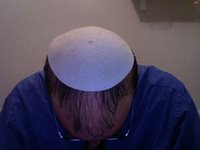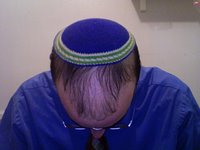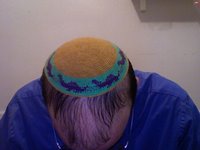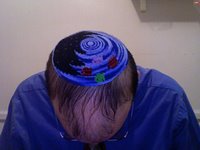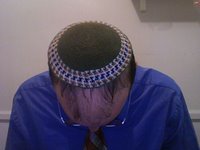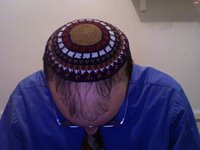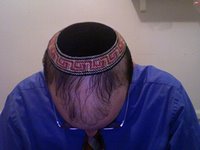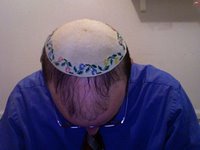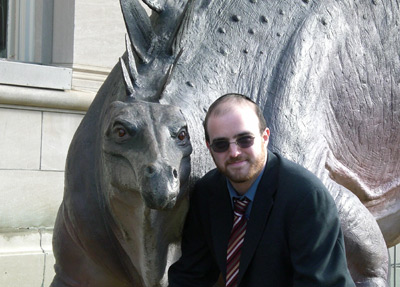Tonight I went to
Yeshivat Chovevei Torah's Henry Guttman Memorial Lecture at the
Hebrew Institute of Riverdale. Rav
Dov Linzer's lecture was titled
Science and Halakha: Strategies and Sympathies, and discussed the conflicting values and sympathies that led to various halakhic authorities over time taking different strategies as to what to do when science and halakha conflict.
For example, there was (of course) the
RMB"M, who valued empirical truth over defending what some see as the honor or stature of Hhazal:
You must, however, not expect that everything our Sages say respecting astronomical matters should agree with observation, for mathematics were not fully developed in those days; and their statements were not based on the authority of the Prophets, but on the knowledge which they either themselves possessed or derived from contemporary men of science. But I will not on that account denounce what they say correctly in accordance with real fact, as untrue or accidentally true. On the contrary, whenever the words of a person can be interpreted in such a manner that they agree with fully established facts, it is the duty of every educated and honest man to do so.
Guide of the Perplexed III:14
And there was
RShB"A, who valued defending the honor or authority of Hhazal over observable fact:
And if this person [who testifies that an animal declared terminal by the Talmud survived a full year] holds firm to his error and says, "No! For I like to be oppositional! I know what I saw, and I will follow it!" We shall say to him, "To spread evil report against the Sages is impossible." And this witness and a thousand like him should be rejected, before we nullify one dot from what was agreed upon by the holy Sages of Israel, the prophets, the sons of prophets, and matters that were said to Moshe from Sinai.
Responsa RShB"A 1:98
What was really interesting, though, was the position of
Hhakham Tzevi Ashkenazi (he who held that everyone must keep one day of yomtov in The Land and two days Outside The Land, no matter where you're from or where you're going) who granted authority to empirically-researched Scientific Fact over
both seemingly-Trustworthy Testimony
and Reality As Described By The Sages:
All those who say it [=a chicken that supposedly was shechted and then found out to lack a heart] is a treifa are in error. Because the matter is clear to anyone who has the heart of a wise person in him and that has a brain in his head, that it is impossible for any living creature in the world to live even for a minute without a heart, and that it should be like a healthy animal. The only case of a "removed heart" [that the Rabbis were referring to] is where immediately after the heart was cut out of the animal it was slaughtered ... And in this case the matter is clear that the heart fell when its stomach was opened, and the cat ate it. And although this is self-evident, and there is no need to bring any proof to this, but to silence the fools who jump to give rulings, beold I found in the Kesef Mishneh, Laws of Schechita, chapter 10, that he explains that Rambam did not list the case of a heart that was removed, or an animal that was born without a heart, and he writes: "Rambam did not list organs that if they are removed it is impossible for the animal to live for even one minute."
Responsa Hhakham Tzevi 74
[One must reject testimony when one knows it is false.] And it was for this purpose that the Rashba toiled in that responsum to bring clear proofs that one cannot reject the Sages' statement that the treifot cannot live under any circumstances for more than twelve months, and that one who testifies to the contrary is testifying falsely. And even if many come and testify likewise, they are all false witnesses, and this was the foundation and the root that Rashba in his great wisdom toiled to establish, as is evident to anyone who studies his words well. And I will bring futher evidence that we are not concerned for the possibility of miracles, and if witnesses come and testify against what we know to be the natural way of the world, we will say that they are false witnesses, and that Nature remains unaltered. As we say in Rosh Hashana, "If the new moon began before noon, then it was seen before sunset, and if it began after noon, then it could not be seen before sunset. Why does this matter? Said Rav Ashi, 'To contradict witnesses.'"
Responsa Hhakham Tzevi 77
The Hhakham Tzevi seemed to hold that Hhazal's inclusion of an "animal missing a necessary organ" in the list of 'terminal'
(tereifa) animals only meant an animal which had an organ removed
immediately before shekhita, so it was still alive — since obviously an animal missing a necessary organ couldn't survive longer than a few seconds, much less any significant amount of time less than a full year. So in contrast to R' Yonatan Eibishitz, who wrote passionately against him, he used scientific/medical knowledge to pretty much define away a halakhic category. R' Eibishitz said that such a seemingly heartless chicken would have to be a
tereifa, and therefore treif, while Hhakham Tzevi said that since a healthy heartless chicken is impossible, it must only be
seemingly heartless, but actually had one, and be kosher — even if reliable witnesses testified that they saw no heart when they cut up the chicken!
Another interesting source was
R' Moshe Feinstein's ruling that a man who had a testicular operation to enable him to have children could marry, against an explicit Talmudic source that defined anyone with a hole in their
(='his' here) testicle as a
petzu‘a daka who is forbidden from marrying due to the fact that he can't have children:
We thus see that unless we are compelled otherwise, we should assume that matters that are dependant on Nature should be based on the assessment of the rabbis of every given time.
Iggrot Moshe EH 2:3
Something at the end that I found the most interesting was
R' Eliyahu Dessler's opinion that when Hhazal gave a reason for a halakhic ruling, they were only giving one — but not the necessarily most important — reason, and therefore we can't change the halakhic ruling based on new circumstances:
For when it comes to the explanations based on nature, it is not that the assumption of nature was the basis for the ruling, but the opposite — the ruling (which was known through tradition) was in need of an explanation, and the explanation that the Gemara gives is not the only explanation possible for this ruling. So, if in certain cases the Gemara gave explanations that were based on the science of their times, it is our responsibility to seek out other explanations that through them the ruling can be established on a firm foundation, based on the science of our times.
Michtav mEliyahu 4 page 355 note 4
What I find particularly interesting about R' Dessler's assumption of pre-existing law is that while this opinion today seems to be more popular among the more non-rationalistic streams of Jewish legal theory, it was in the middle ages pushed by the rationalist
pashtanim like
RD"Q, who claimed that all of the Sages' derivations of laws from verses in the Torah was nothing more than mnemonics and
asmakhta — Torah Shebe‘al Peh actually stands on its own as an independent and pre-existent code that didn't need human development.
NOTE: translations of sources are from R' Linzer's bilingual source sheets.



